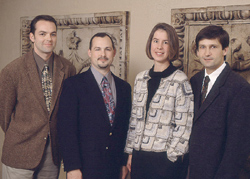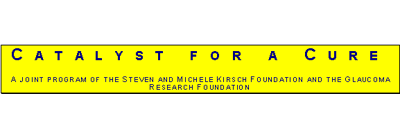  |
CATALYST FOR A CURE (CFC), the innovative partnership established in June 2001 between the Kirsch Foundation and the Glaucoma Research Foundation (GRF), was a three-year program totaling $1,460,000-plus in funding. CFC announced in January 2002 the selection of the researchers for the consortium. The members were:
- David Calkins, PhD (originally at The University of Rochester, Rochester, New York, now at Vanderbilt University School of Medicine, Nashville, Tennessee)
"I believe the strength of the consortium lies in the breadth of expertise from which it draws. The great variety of skills and knowledge we bring to bear really encourages us to think "out of the box" or in ways that we, as individuals, may not be used to."
- Philip Horner, PhD (University of Washington, Seattle, Washington)
"Unraveling the mysteries of degenerative disease requires a multidisciplinary approach that could not be accomplished by any one particular laboratory. Catalyst for a Cure is a unique model for facilitating collaboration among laboratories with distinctive interests and technologies."
- Nicholas Marsh-Armstrong, PhD (Kennedy-Krieger Institute, Baltimore, Maryland)
"CFC provides an opportunity to try a different model of doing science. This highly directed and interactive approach will benefit not only glaucoma research, but also all those who are involved in the project."
- Monica Vetter, PhD (University of Utah, Salt Lake City, Utah)
"Glaucoma is a devastating problem that could be better understood by applying the tools of modern biology. I am very excited to be a part of the CFC consortium, and feel privileged to be able to work together with a group of talented neuroscientists to tackle this problem. It is unusual for foundations to use funding to encourage investigators to pool their talents to tackle a common problem. I am pleased that we have gathered a diverse group of scientists who can work well together, and I am optimistic that in the next three years that we can gain some new insights into the mechanisms underlying glaucoma."

|
Left to right: Philip Horner, David Calkins, Monica Vetter, Nicholas Marsh-Armstrong
|
This outstanding group has been using recent breakthroughs in neuroscience, molecular biology, genetics and immunology to identify and answer key questions about the causes and mechanisms that lead a person to develop the debilitating eye disease known as glaucoma. To learn more about this group, please see our CFC researchers page. To view the consortium structure, please see this powerpoint diagram.
The original advisory group for the CFC included:
- Jack Antel, PhD, Professor of Neurology (McGill University, Montreal, Canada)
- Constance Cepko, PhD, Professor, Department of Genetics (Harvard Medical School, Boston, Massachusetts)
- Moses Chao, PhD, Professor of Cell Biology, Physiology and Neuroscience (New York University School of Medicine, New York, New York)
- Martin Wax, MD, Professor of Ophthalmology and Visual Sciences (Washington University School of Medicine, St. Louis, Missouri)
About our funding partner:
 |
The Glaucoma Research Foundation (GRF) was created in 1978 and is the oldest national voluntary health agency dedicated to protecting the sight and independence of people with glaucoma.
|
While the Kirsch Foundation is no longer a part of this project, GRF has committed to supporting the CFC project through 2007. Please see the GRF website for current updates on the CFC project.
Read the archived Year 1, Year 2, and Year 3 Annual Meeting and Progress Reports.
Publications Resulting from the CFC Project
PJ Horner and FH Gage. 2002. Regeneration in the adult and aging brain. Archives of Neurology. 59(11):1717-1720.
AC Lipson and PJ Horner. 2002. Potent possibilities: Endogenous stem cells in the adult spinal cord. Progress in Brain Research. 137:283-297.
PJ Horner and TD Palmer. 2003. La vida loca! The nightlife of an astrocyte. Trends in Neuroscience. 26(11): 597-603.
DM Inman, ML McGaughey, & PJ Horner. 2003. Proliferation of cells in the normal adult retina and after selective apoptotic ganglion cell death. Program No. 567.32. Society For Neuroscience Meeting. New Orleans.
MB LoMonaco, RM Sappington, & DJ Calkins. 2003. Modulation of intrinsic and extrinsic programs of apoptosis in retinal ganglion cells in an in vitro model of glaucoma. Program No. 210.2. Society For Neuroscience Meeting. New Orleans.
M McGaughey, RM Sappington, DM Inman, DJ Calkins, & PJ Horner. 2003. A comparative study of NG2 cell phenotypes and distribution in the adult retina and a model of glaucoma. Program No. 567.33. Society For Neuroscience Meeting. New Orleans.
D Milatovic, S Zala-Milatovic, KS Montine, PJ Horner, & TJ Montine. 2003. Pharmacologic suppression of neuronal oxidative damage and dendritic degeneration following direct activation of glial innate immunity in mouse cerebrum. Journal of Neurochemistry. 87(6):1518-26.
RM Sappington, MB LoMonaco, & DJ Calkins. 2003. Retinal glial cells produce vascular endothelial growth factor in an in vitro model of glaucoma. Program No. 632.12. Society For Neuroscience Meeting. New Orleans.
CJ Burns, T Ishikawa, MM Taketo, ML Vetter, & S Fuhrmann. 2004. Frizzled 5 function during early eye development. Society For Neuroscience Meeting. San Diego.
N Marsh-Armstrong, M Steele, & ML Vetter. 2004. Phylogenetic footprinting and functional analysis of regulatory sequences in frizzle-5 genes. Program No. 567-31. Society For Neuroscience Meeting. San Diego.
DA Hutcheson, MI Hanson, KB Moore, TT Le, NL Brown, & ML Vetter. In press. bHLH-dependent and –independent modes of Ath5 gene regulation during retinal development. Development.
RM Sappington and DJ Calkins. In review. Elevated pressure induces proteosome-dependent secretion of cytokines and activation of NFκB in retinal glial cells. Ophthal. Vis. Sci.
BP Buckingham, DM Inman, & PJ Horner. In preparation. Axon trauma, not retinal ganglion cell loss, contributes to visual defects in the DBA/2 mouse model of glaucoma.
DM Inman, B Buckingham, RM Sappington, DJ Calkins, & PJ Horner. In preparation. Regulation of cell proliferation intact despite dramatic glial changes over time in the DBA/2 mouse model of glaucoma.
|
 |
|




